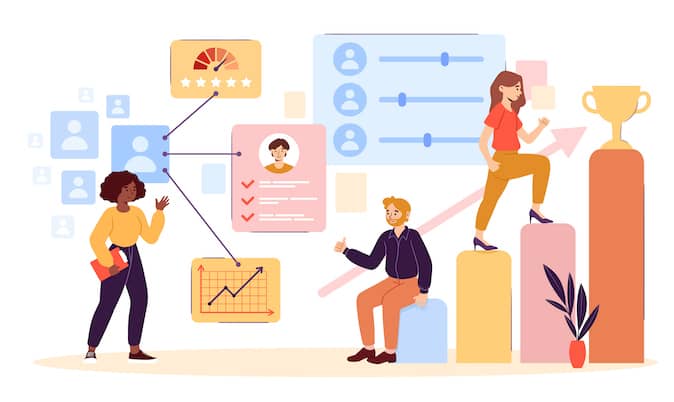Mastering Employee Evaluations in 2025: A Comprehensive Guide

In today's competitive business landscape, it's critical for companies to understand how every facet of the business performs. But it's impossible to understand business performance without first understanding employee performance - after all, employees are at the heart of any successful organization.
That's where employee evaluations come in. Employee evaluations offer an opportunity to identify employee strengths and areas for improvement, guide goal-setting and progress against goals, provide constructive feedback, build relationships and rapport, and ultimately foster employee growth and development.
As such, employee evaluations shouldn't be limited to once or twice a year - they should be a part of a continuous performance development process that checks in with employees at regular intervals.
At Workhuman, we call this creating a culture of ongoing feedback that builds connection across employees and managers and ultimately creates more engaged, productive employees. It's, in fact, part of our ongoing commitment to build more human-centric workplaces, where employees thrive because they're valued for who they are as people - not just for the work they do at the organization. And this starts by having regular, meaningful, valuable conversations with employees that are both retrospective and forward-looking in nature. In essence, it's setting people up to flourish on a daily basis.
But what does this look like in practice? Let's take a closer look at employee evaluations to better understand how best to structure for maximum impact:
What is an employee evaluation?
Put simply, an employee evaluation is a systematic process that employees go through to assess their work performance, skills, recent accomplishments, and weaknesses.
An employee evaluation is a process that aims to celebrate growth, recognize effort and skill, and spot any areas that could use development. It should be an ongoing dialogue that cultivates individual, team, and organizational wins by balancing personalized development with shared objectives.
What are the benefits of employee evaluations?
Employee evaluations can help all team members better their performance by reflecting on what drove success and what fell short. It’s not about checking boxes. These evaluations are ideally well thought-out and can provide helpful context for future conversations about professional development and compensation.
But the benefits don’t stop there. Let’s run through a few other positives.
Establishing regular performance standards
With an employee evaluation process, managers can build measurable performance management standards and clear expectations for the entire team.
Establishing regular performance standards is a way to ensure everyone understands their role, as well as what is expected of them and what they will be held accountable for. But what's the best way to establish performance standards?
Create SMART goals
SMART goalsOpens in a new tab stand for Specific, Measurable, Achievable, Relevant, and Time-Bound. In short, managers need to develop these goals according to previous evaluation notes taken in earlier assessments. SMART goals are easy to track and can help set reasonable expectations for future performance.
Gather data for the future
When managers put together employee evaluations, they can use prior employee feedback to inform training and development opportunities that help employees achieve their goals.
Build valid success metrics

Employee performance metrics should be established based on information shared in employee evaluations. Once established, these success metrics can help build greater transparency, accountability, trust, rapport, and overall workplace culture.
Purpose and objectives
Besides helping organizations grow, employee evaluations are conducted with particular objectives in mind. Here are some of the primary objectives:
Identifying strengths and areas of development
An employee evaluation offers the opportunity to identify strengths as well as areas for improvement. Employees should be encouraged to provide specific examples of successes, good collaboration or communication, and challenges in their evaluations, which can then be reviewed by their managers and discussed with the employee.
The employee appraisal of how something went or how they performed is a vital perspective when it comes to working on a solution that will work well for them.
But, while it's helpful to know what could have gone better, it's equally helpful to know what is already going well. Employee evaluations can bring strengths to the surface, which can inform future professional development and skill-building opportunities.
Aligning individual and organizational goals
Employee evaluations give employees the opportunity to view their performance in relation to and through the lens of the organization's overall performance and business goals.
A company's mission, values, and departmental and employee goals should work cohesively, and it’s important employees and managers understand where they fit into helping the company succeed.

Common evaluation techniques
There’s no one-size-fits-all approach to employee evaluations. There are many forms of evaluation, and managers should employ as many as possible to get a holistic view of an employee’s performance and limit the opportunities for bias on behalf of one person to influence the assessment. Here are a few examples of employee evaluations:
Self-assessment
As evidenced by the name, self-assessment is a form of evaluation that allows the individual employee to analyze and share their strengths and areas for development. This perspective is a uniquely valuable part of the employee evaluation, as it demonstrates the degree of employee introspection, as well as the individual's assessment of priorities, focus areas, and so on.
Peer review
Peer review is a form of employee evaluation that uses peers and co-workers to assess one another's performances. By getting the perspective of another team member, managers can gauge whether an employee is communicating and collaborating successfully on projects and tasks.
Management evaluation
A manager evaluation can be interpreted in a few ways. One is for managers to provide an evaluation of an employee’s performance. The other is for the employee to provide an evaluation of a manager’s performance. Both are strong components of a performance review process.
360-degree feedback
Combining self-assessments, peer reviews, and manager evaluations gives managers a complete view of an employee’s performance. This is 360-degree feedback. Managers could stretch it further by reaching out to customers or vendors the employee works with, too.

What's the best way to write an effective employee evaluation?
To write an effective employee evaluation, questions should be open-ended, and employees should provide examples of events, projects, and tasks that inform their assessment. All types of employee evaluations need to cover more than just strengths and areas for development.
The same goes for peer and manager evaluations. Manager comments and recommendations will likely carry additional weight, so specificity can be especially impactful. The following tips can be useful in creating an effective employee evaluation:
Prepare for the evaluation
One of the best ways to prepare for an employee evaluation is by reviewing the time period in question. In keeping with the continuous performance development mindset, quarterly evaluations of some kind keep consistent tabs on employees’ performance as the organization is doing the same for itself.
An easy way to keep track of all of those assignments and moments throughout the quarter is with Conversations® from Workhuman®. It’s easy to lose track of everything everyone is working on, and, again, specifics play an important role when evaluating employees.
Writing the evaluation
When writing any kind of performance feedback, it’s best to use clear and concise language that doesn’t leave any room for confusion. As for what to put down exactly, it's a good idea to start with the positives. Employees should have the opportunity to talk about areas where they excel and what they do best.
The feedback sandwich approach of positive, negative, and then more positive feedback doesn’t exactly hold up. In fact, according to the 2014 study, "The sandwich feedback method: Not very tasty," it can actually hinder performance and is often used by managers out of "fear of offending the employee."
Instead, managers should focus on weaving constructive feedback throughout the process rather than sectioning it off.
As opposed to past performance appraisals, an evaluation as part of a continuous performance development approach should take any surprise or sting out of an employee evaluation.
If something isn’t going well, it shouldn’t wait until it's evaluation time; it should be addressed promptly. How that adjustment went is then the fodder that will inform comments shared in an employee evaluation.
It's important to keep in mind that an employee evaluation is an actionable document. An evaluation should empower employees and the organization to act. It shouldn’t bring employees down or make them feel bad at their job.
The evaluation must contain direct feedback with solution suggestions to help eliminate confusion.
Conducting the evaluation meeting
After completing the evaluation, the next step should be setting up a meeting to discuss any questions or issues. Whether virtual or face-to-face, meetings are an excellent opportunity for mutual understanding, clarity, and development.
When conducting an employee evaluation, open-ended questions should be used instead of simply going through the written evaluation.
Questions like “What challenges did you face during this period?” or “How do you feel about the tasks assigned?” are good conversation starters.
Once complete, managers should document the specific points discussed and the agreed-upon action for future performance enhancement and meetings.

Best practices and pitfalls to avoid
At their best, employee evaluations help find strengths and improve performance. However, if rolled out haphazardly, they run the risk of wasting time and effort.
Here are best practices to incorporate and common mistakes to avoid:
Maintain confidentiality
Proper confidentiality ensures employees feel safe and protected, encouraging further candid feedback. Most importantly, it shows the employees that they can trust their managers with open and honest feedback, whether given or received.
Managers should ensure all evaluation documents are stored and sealed securely. This means that only personnel with access should be HR staff or direct supervisors.
Be consistent and fair
For employees to grow and thrive, employee evaluations should be done done fairly and consistently. Fair evaluations are critical to a successful diversity, equity, and inclusion strategy.
Employees are more likely to accept the feedback when they perceive the process as fair.
Conversely, if evaluations aren’t fair or constructive, managers will contend with demotivation, mistrust, and even potential legal issues.
As such, managers should use the same job performance template for everyone—at least those in the same department. It's also a good idea to keep an eye out for employee evaluation comments that don’t directly pertain to job performance - in other words, managers should lead by example, modeling objectivity and fairness in evaluations.
Allow for two-way feedback
Managers should always practice actively listening to everything employees verbalize in evaluations and revisit old documentation to solve any issues or concerns that may arise.
Leverage technology
To help with specific examples of accomplishments or efforts throughout the year, managers can turn to platforms designed to track them, like Workhuman's Social Recognition® platform.
An employee recognition platform not only keeps managers informed of the latest milestones in the workplace but also allows for peer-to-peer connection, encouraging productivity.

FAQs
What is the best method for conducting employee evaluations?
As mentioned earlier, there’s no one-size-fits-all answer here. Depending on the company and its objectives, managers can choose one of the following employee evaluation forms:
- Self-assessment
- Peer review
- Management evaluation
- 360-degree feedback
How often should employee evaluations be conducted?
While some companies prefer an annual performance review, conducting one at least every six months is best to maintain continuous performance development for employees. Better yet, managers can conduct evaluations every three months. This can help identify areas for improvement and recognize employee efforts quickly and consistently.
What should be done if an employee disagrees with their evaluation?
The first thing to do in this situation is to let the employee talk, listening to - and actively hearing - why the employee disagrees with the evaluation. After that, managers and employees can review the evaluation together and review previous data to explain the basis for the feedback. If necessary, an impartial third party can be brought in to help with the review process.
Conclusion
In short, employee evaluations are the cornerstone of progress. They come in many forms, like self-assessment, peer review, and management evaluation, each with its own benefits.
With an effective evaluation process, managers and employees alike can enjoy better performance standards, plenty of data, SMART goals, and success metrics that can help the company expand and progress more. However, proper performance development is only possible with fair, objective, and transparent evaluations.
About the author
Ryan Stoltz
Ryan is a search marketing manager and content strategist at Workhuman where he writes on the next evolution of the workplace. Outside of the workplace, he's a diehard 49ers fan, comedy junkie, and has trouble avoiding sweets on a nightly basis.